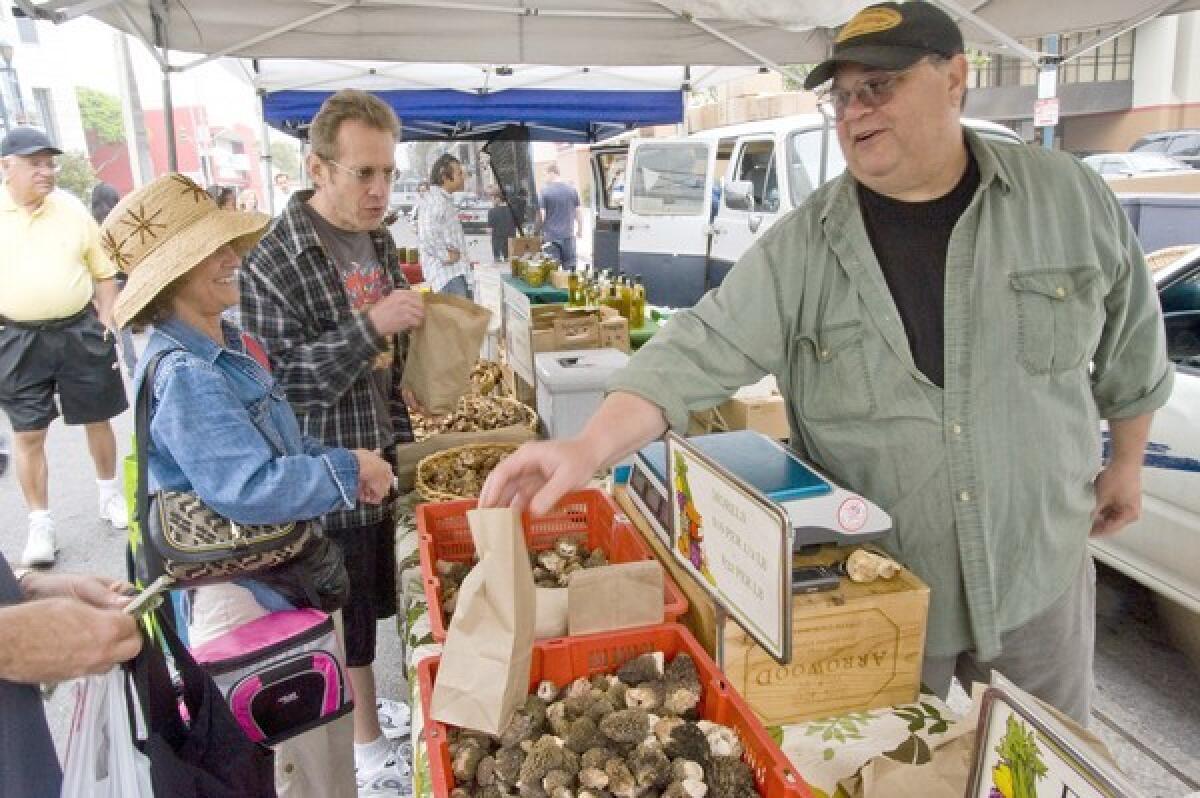Market Watch: Spring porcini now in season

- Share via
Spring porcini, among the most prized and delicious of wild mushrooms, have started their brief season at a few local farmers markets. Most people think of porcini and kindred fungi, known as boletes, as being specialties of autumn, and so they are in Europe and the Eastern United States, but here in the Western states we have our own species, the “spring king,” as it is sometimes called, with the same excellent flavor — earthy, nutty and meaty — and its own season, habitat and commerce.
Spring porcini have been harvested in California for more than a century, but a commercial trade, with professional foragers and buy points, only developed around 1985, according to a 2008 article in the journal Economic Botany by fungi expert David Arora. These were long considered to be Boletus edulis, like the most common porcini of the Old World, but based on molecular data, differences in form and the spring king’s distinctive habitat — the pine forests of inland mountains west of the Rockies — Arora made a convincing case for calling it a new species, B. rex-veris.
We also have fall porcini in California, but they are not as firm or common and thus are less readily available, according to David West of Clearwater Farms, the longtime leading purveyor of wild mushrooms at farmers markets. “Fall porcini only come up after a lot of rain, and it’s warmer in the fall than it is in the spring, so they’re softer and more prone to bugs,” he says. “Most end up in the dried market.”
West, who was born in 1958 and grew up in Flatbush, Brooklyn, is one of the most beloved and charismatic of farmers market vendors, always schmoozing with customers and telling slightly off-color jokes with a professional’s zing. After moving to California in 1988, he worked for a mushroom vendor at farmers markets, where he made contacts that were crucial when he later opened his own stand at the Santa Monica (Wednesday and Saturday Organic) and Hollywood (Sunday) markets.
West lived with his wife, Frances, a psychoanalyst, in Santa Monica until last year, when they moved to Goleta, west of Santa Barbara, where he says they enjoy smelling the ocean breeze and hearing the barking of sea lions. Several times a week he or his assistant, Karl Oldnettle, drives to LAX airport to pick up baskets of fresh mushrooms sent by foragers in Northern California. Most of the spring porcini come from public lands near Mt. Shasta, he says.
Porcini cultivation has long been considered impossible or infeasible, because of the complex mycorrhizal relationship between these mushrooms and their host trees, possibly involving bacteria or other fungi. Scientists have researched techniques for inoculating porcini spawn, and at least one company, the Edulis Group of South Africa, claimed to be cultivating porcini, but it is not clear that anyone has yet succeeded commercially. All porcini sold here are true wild mushrooms, gathered from the forests, so they are always more expensive than the cultivated forms like shiitakes and portobellos.
Recently West has been selling his top grade of porcini for $36 a pound, and the second grade for $28. Both kinds were picked at the same time, but the more expensive ones are younger and firmer, and so keep longer. “They are so sweet and buttery that you can eat them raw,” he says. “The older ones are softer and have a richer, earthier flavor for sauces.”
West says he can’t choose a favorite among his three top wild mushrooms — morels (also in season now), chanterelles and porcini — but he does admit that porcini are the only kind he can’t stop himself from eating straight from the pan. He likes to sauté them in thin slices, or grill fat chunks, he says.
His porcini should be available until July 4 if the weather remains relatively mild; afterward they may still be picked at high elevations, but it gets so hot in the valleys that the delicate mushrooms would spoil on the tarmac while in transit. They are most abundant at West’s stand on Wednesdays, because his most experienced picker has a regular job during the week and harvests only on weekends.
West sells about 80% of his supply to farmers market retail customers, and the rest to restaurants, including Campanile, Capo, Melisse and Providence. Last Saturday, Evan Funke, executive chef of Rustic Canyon, stopped by to place an order and described some of the ways he used porcini: roasted pork chops with nectarines and porcini (perhaps unconsciously taking into account their name, which means “piglets” in Italian); shaved artichoke salad with shaved raw porcini; and crispy white polenta with sunny-side-up egg, porcini and Parmigiano-Reggiano cheese.
Unlike most fresh produce offered at certified farmers markets, spring kings must be sold in the noncertified section, because their growing grounds are typically public land, and harvests are uncertain, so inspectors cannot provide an agricultural production certificate for vendors. But the sale of California porcini is fully in keeping with the spirit of the markets, making available a premium product, as fresh as can be, with minimal markup from middlemen.
More to Read
Eat your way across L.A.
Get our weekly Tasting Notes newsletter for reviews, news and more.
You may occasionally receive promotional content from the Los Angeles Times.










